IMDb meta-data is runtime of 2 hours and 10 minutes, rated a measly 6.2 by a paltry 2129 cinemitizens.
Genre: Sy Fy when it was made, fact now.
Verdict: memorable as well as prescient.
An indictment of reality television made forty years ago by a French director with an English-speaking cast in Scotland. Bored the fraternity brothers to sleep.

In the near future, medical science has eradicated nearly all diseases. Most of us die of old age in our beds. But not all. There are still some incurable, fatal diseases.
Recognising a market niche, the Television Network launches a reality program called ‘Death Watch’ which will air the final, death agony of individuals with such rare diseases. The concept is salacious, puerile, invasive, vulgar, and crass, all the qualities of a ratings winner. Coming to Channel 7Mate soon! Why do I think of Richard Carlton? (Nigel Kneale did something even more cynical in the ‘The Year of the Sex Olympics’ (1968), reviewed elsewhere on this blog.)
Filming old folks in hospice care cacking it is rejected as boring what with bed pans and all. Who wants to see wizened oldsters croak anyway.
Better that the victim is young, preferably with a tear-jerked family, and seemingly healthy before the wasting away and pain begins. The bored cynicism of the producers is heavy duty. Into the frame comes Romy Schneider. She is diagnosed and prognosed in a one shot stop.
She goes through the stages of grief: denial, anger, bargaining, depression, acceptance, and shopping for the remainder of the film.
First off, the carrion eaters descend to pick her living carcass. In return for the exclusive rights to broadcast her death, the Network will shield her from the other vultures. There’s the bargain, Faustia. Surrender privacy to get privacy. Romy refuses and is besieged by the free press. She is harassed, hounded, humiliated to get reaction shots. Evasive tactics are demeaning and exhausting. She becomes a celebrity, signing autographs, getting book deal offers, and so on. That is depressing in itself.
She relents and takes the money, and then runs. She is shadowed, accompanied, and sometimes protected, and at other times manipulated by Harv who is the Network’s agent. Here is the Sy Fy gimmick, he has a camera eye. He transmits her flight back to the studio which edits and airs it. (Herbert Lom had one of those in ‘Journey to the Far Side of the Sun [1969],’ reviewed elsewhere on this blog. Didn’t do him much good. Too bad Harv did not know that before he cut his eye out to make way for the camera.)
Harv makes sure that she never realises this is going on. On the run, they are, after all, trying to avoid others, hiding out in the gloaming, darting through the heather, though not a single tam o’shanter nor a man in a skirt was sighted. These latter omissions made the dozing fraternity brothers question the claim of location shooting in Scotland. Where are the cat strangling bagpipe players, they asked.
Most of the runtime is these two leaving a grey on grey Glasgow and travelling the hinterland to the coast so that she can see the sea and die. It becomes a road movie that we have seen many times before, albeit one with a sharp edge. As Harv plays her to spin out the story, the producer manipulates him to do ever more to wring the sob out of the story. The manipulator is himself manipulated per Michel Foucault. It takes Harv a long time to realise that. Not the sharpest knife in the hack’s drawer is that one.
The mouth-breathing passive viewers of Channel 7Mate lap it up.
In this future the conditions are mostly Third World, perhaps we are all living longer but not producing more since we are watching Channel 7Mate all day. Glasgow looked better after German bombings than it does here. Most people dress in worn rags. Even the Network producer drives around in a dilapidated Leyland.
Unlike so much Sy Fy which is replete with gizmos, this one is shorn of that paraphernalia, much to the irritation of some reviewers on the IMDb. The only toy is Harv’s camera eye (and in one scene a Siri computer the size of a refrigerator). Moreover, and again in contrast to Sy Fy norms, no one is out there roaming the galaxy, but rather the focus is introspective. Additionally, it celebrates nature rather than the stars, though not quite in the same intense reverence as Edward G Robinson’s final scene in ‘Soylent Green’ (1973), not yet reviewed, because it depresses the fraternity brothers.
The musical score is perfectly aligned to the ambience. That is another departure from the Sy Fy norm where usually the score is bolted on later, priced by the minute.
That 6.2 rating puts it 0.2 points ahead of D-movies like ‘The Earth Dies Screaming’ (1964), reviewed elsewhere on this blog. Figure that out.
Bertrand Tavernier, lawyer turned cinemaista, is the director, writer, and producer, whatever the credits say. Like Howard Hawks, his intellectual fingerprints on a film are obvious.
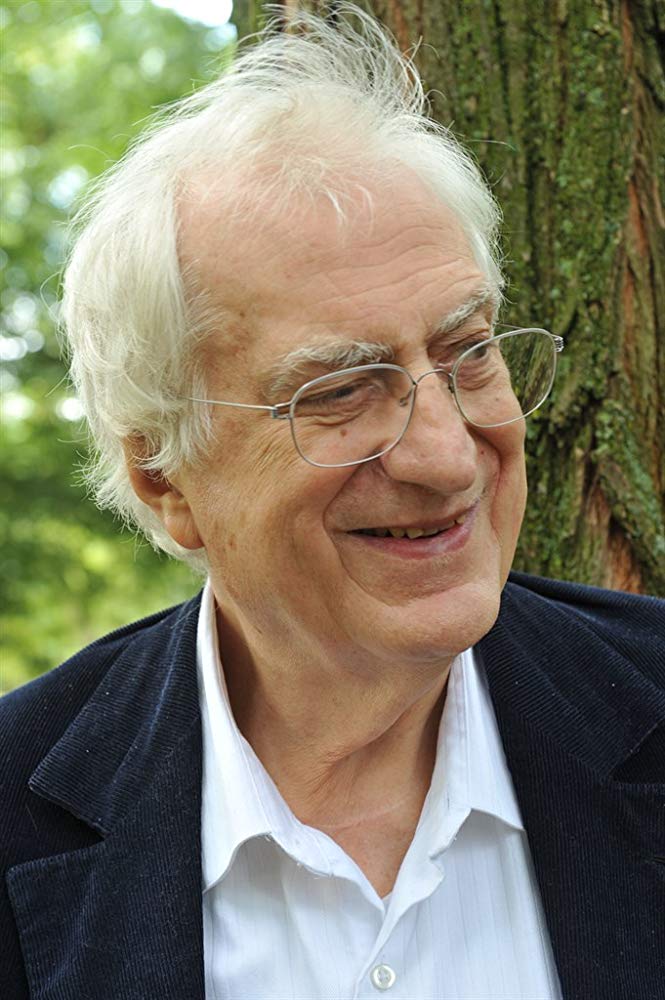
There is a 2012 informative and thoughtful short interview with him about this film on You Tube (https://www.youtube.com/watch?v=TpaVvh51Rbw). It remained as fresh in his mind during this interview thirty years later as the day it started.
Some of his other credits include these noteworthy titles:
‘Quai d’Orsay’ (2013) – a fool become foreign minister
‘In the Electric Mists’ (2009) – a mystical krimi in NOLA
‘It all Starts Today’ (1999) – a school teacher learns from children
‘Life and Nothing But’ (1989) – a bitter veteran buries the dead
‘Clean Slate’ (1981) – white savages in Africa
‘The Watchmaker’ (1972) – a father’s love is blind
For Romy perhaps the ones to name are the enigmatic Rosalie or the spectral Chantal.
Month: July 2018
‘Phantom Planet’ (1961)
IMDb meta-data is 1 hour and 22 minutes of Dali time, overrated at 3.3 by 2302 cinemitizens. (How come so many votes for this loser? Dunno.)
Genre: Sy Fy
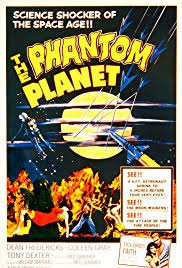
Verdict: Davy Crockett in space!
The set up is this: in far distant 1980 the United States Air Force is rocketing hither and thither, Mars, Woolworths, Venus…per Marvin Miller’s opening voiceover. (Marv was taking time off from handing out the dosh for ‘The Millionaire.’)
Get this, the pressure suits of the astronauts (and that term is used) have the Davy Crockett touch, a fringe along the arms to keep the space flies away.
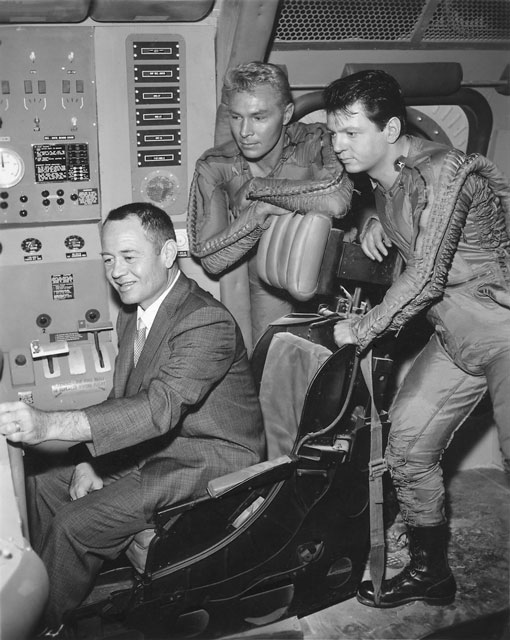 Check out the fringe down the left forearm of the dark-haired red shirt.
Check out the fringe down the left forearm of the dark-haired red shirt.
We see these same two fringed pressure suits on no less than eight astronauts, two at a time, throughout the eternity of this film. Even the fraternity brothers noticed the fringe on the fourth viewing.
One of the USAF rockets goes missing. Who you gonna call to find a missing rocket? Steve Canyon, that’s who! A bleached, gaunt, and comatose Steve, but Steve nonetheless.* He reaches for the clichés and says ‘it is too quiet’ in space. Vacuums are like that, Steverino! Maybe Steve shouldn’t have graduated from spaceboy school.
Spruced up after a meteor shower, Steve manages to lose his co-pilot in that too quiet space vacuum, accompanied by the Lord’s prayer. Yep. It takes Steve a while to notice this loss, and he recovers from the emotional trauma in seconds. That’s, Steve! Tough as nails where others are concerned.
By the physics of scriptwriting he ends up on an asteroid, which is sometimes called a planet. Confusing, no? Confusing, yes! He collapses in despair after reading the rest of script. Urgh. Then the leprechauns appear. Is this Ireland? They certainly are little people.
The Lilliputians are led by Nebraska’s own Anthony Dexter, on whom more in a moment. Rather than stake Steve to the ground like a beached Gulliver, Dex has a better idea. Open his face mask. They do. The catatonic, I think but with him it is hard to tell, Steve breathes the asteroid’s air. (Yes this weeny asteroid has an atmosphere in the script if not in physics.) This is the good scene. Steve shrinks inside the fringed pressure suit to Lilliputian-size. Every part of him shrinks. Get it? Now the whole of Steve is six inches. The fraternity brothers shrivelled.
Turns out the planet-asteroid is called Rayton, Rayon, Rheton, or something and flies around under the control the oldest alien seen in B-movie land, namely Francis X. Bushman, who is obviously reading lines from cue cards most of the time and still gives a better performance than the rest of them. This old stager was born in 1883. Driving an asteroid was a demotion for him because the year before he had been Secretary General of the International Space Order in ’12 to the Moon’ (1960), reviewed elsewhere on this blog. Earlier still in 1925 he had been Ben Hur and drove his own chariot. Experienced he is then at driving.
By the way, the controls are Tibetan rock crystals and X just waves his hands over them. This trope became a commonplace when theremin players were recruited as UFO pilots.
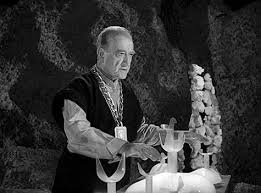 With X at the helm there are no worries.
With X at the helm there are no worries.
Steve wants to fill out his pressure suit again and go home. The Raytons are shy and do not want to become a tourist destination, so are reluctant to let him go. To show him hospitality a jury of six young women sentences him to stay. They do so in silence. See, shy. Then the Solar Panelists attack, led by Jaws in the strangest rubber duck suit yet seen outside a bathtub.
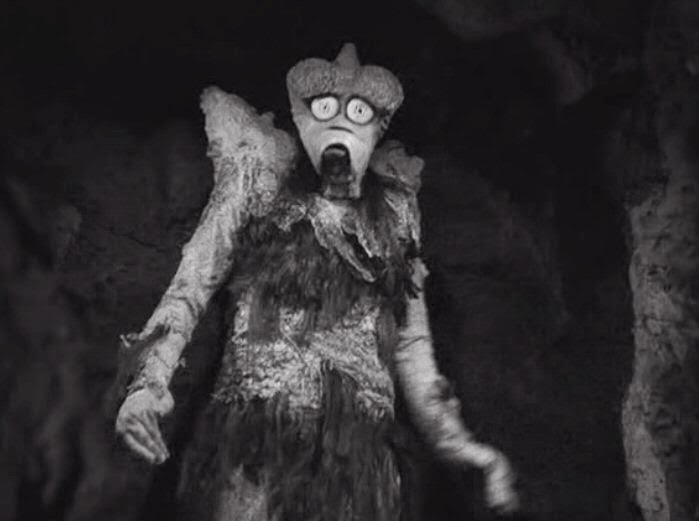 See.
See.
They fight it out. Fight. Fight. Fight.
Fighting back-to-back bonds Steve and Dex, who then shows Steve how to escape, full-sized and fully functional.
The end.
Dex is Nebraska’s own; he peaked as ‘Valentino’ (1951). His next lead was in ‘Fire Maidens from Outer Space’ (1956), reviewed elsewhere on this blog. Dex was also with X in ’12 to the Moon’ so they could reminiscence about that around the script-fire.
The fraternity brothers could detect no Cold War themes in this movie. If there was such a message they did not receive it. Situation normal.
Disclosure statement. I watched this ages ago and no write up followed because of the benumbed state that viewing produced in me. Now that I have been hardened by so much else, I watched it again, such is my dedication to bleaders.
* For years the syllabus in ‘Power’ had this entry: ‘Beyond Steve Canyon and Rambo: Histories of Militarized Masculinity’ by Cynthia Enloe. The reference here is to the comic book which became a television series in the 1950s.
‘The Thing’ (1951)
IMBd meta-data is runtime 1 hour and 27 speedy minutes, rated a measly 7.2 by 21,596 cinemitizens.
Verdict: Chapeaux!
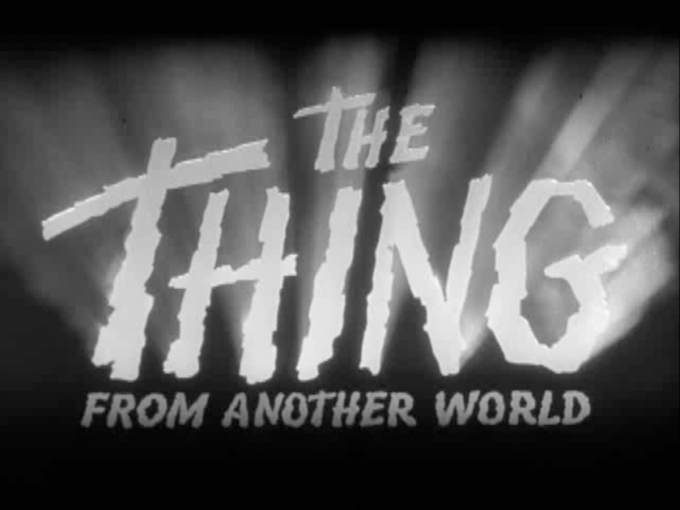
At a remote scientific station above the Arctic Circle in Alaska a giant carrot appears with a taste for blood!
Here’s the set up. A NORAD airbase tracks an incoming craft that crashes near a polar science station. Since it is time for a supply run to the base, Captain Tobey and his crew are dispatched to deliver the goods and check the wreck. Simple. Ah huh! That’s what they think. (No one seems to think it could be a Russkie.)
After that leisurely start the pace increases. Finding skid marks on the ice, and a shadow under the ice, as if a hot object had slid along and then burned into the ice which then froze back over it, they fan out to measure its shape. It is one of the several brilliant moments in the film. As they shuffle around beating their arms to keep warm in the Arctic wind, they come to form a circle which no one notices since each is preoccupied with slippery footing and the biting cold, until…..
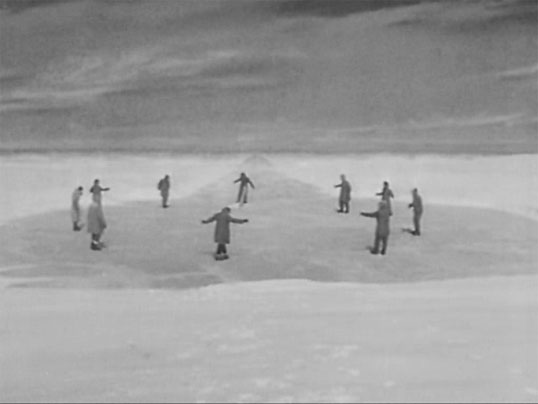
‘We found one,’ says one of the grunts in amazement. (You either get it, or you don’t.)
After some of this and that, they find an NBA body frozen in the ice and drag that sizeable block of ice back to the station for further examination. By now the weather, per script, has closed in and they are cut off from the outside world in the Science Station of Otranto.
The ice block thaws and a very hungry Marshall Dillon emerges to find a late lunch. Several huskies will do, one of which tears his arm off. No problem, he will just grow another one. Bullets have no effect.
The scientists examine the detached arm and conclude…. It is a carrot!
When Carrot Dillon runs out of dogs, the scientists are next in line. Gulp! This is some vegetarian.
Howard Hawks wrote, directed, edited, and produced this masterpiece. The results is a B movie with A movie pizzazz. It has all the touches of this cinema doyen. Overlapping dialogue as two or three people talk at once. When Robert Altman did that in ‘Nashville’ (1975) he was hailed as a genius. Old news to cinemitizens. Role reversals when a woman takes charge of Captain Tobey. Inverted hierarchy when the best ideas come from subordinates.
Moreover, the soldiers act like scientists and the scientists act like soldiers. That is, the soldiers discuss the problem, test responses, revise, amend, try again, evaluate, and improvise. The scientists obey the senior man’s silly orders and he holds to his interpretation of the facts despite the evidence to the contrary.
The Captain’s authority lies in melding the men together, not in shouting out solutions or orders. The Senior Scientist, by contrast, gives only orders and silences other voices.
There are two women at the station and neither screams. One offers the first practical response to the Thing. How un1950s it all is.
Equally unusual is the presence at the station of Chinese cook who is later there at the denouement, cleaver in hand ready to fight this man-eating carrot. In most films of the day such a character would have been comic relief, i.e., stupidly stereotyped, and then forgotten.
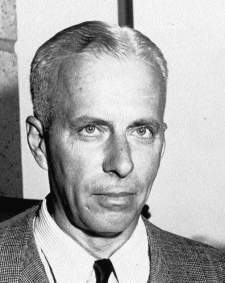 Howard Hawks
Howard Hawks
Like Frank Capra, Hawks gives the supporting actors facetime and some of the best lines. It is a large ensemble cast of perhaps twenty and everyone of them has a line or two.
The conflict between the scientist and the soldiers is a trope in Sy Fy, but here, before it was done to death by later and lesser hands, it is fresh and vital. The scientist wants to keep Thing alive at all costs, including his own life. It is a being from another world. ‘We must communicate with it.’ ‘We must study it.’ ‘We must learn from it.’ He goes like it is the Second Coming. ‘What are a few human lives compared to the chance to learn from a creature of another world.’ Well….
To his credit, the Senior Scientist risks his own life to try to communicate with Thing, and in this the soldiers give him due acknowledgement for the courage of his convictions. Nicely done. No cardboard plot devices here.
By contrast the soldiers know an enemy when he attacks and respond in kind. It is a perfect contrast in almost every way to its 1951 cousin ‘The Day the Earth Stood Still’ where Klaatu came in peace. The Carrot from another world came for dinner!
At the end, the final words are a warning ‘to watch the skies’ because more may be on the way. Of course in 1951 Thing has to be a Red Thing. Hence, carrot.
It has been remade number of times but I have never bothered to watch the imitations. Though I note that Janne Wass of ‘Scifist’ writes that John Carpenter’s version ‘The Thing’ (1982) is one of the finest science fiction films ever made, and Janne is an oracle on these matters.
Wass and others go on about the Senior Scientist, with his double-breasted brass-buttoned blazer there in the Arctic hut, sporting a fur hat and a roll-neck cashmere turtle neck sweater. He has a goatee which suggests, to the rune-readers, that he is homosexual, a Russian spy, a villain, a male model, a…. Well he is the pole of an argument but as for the rest. No dice.
He presents his arguments and he lives up to them. In the end the soldiers pay him his due for that.
